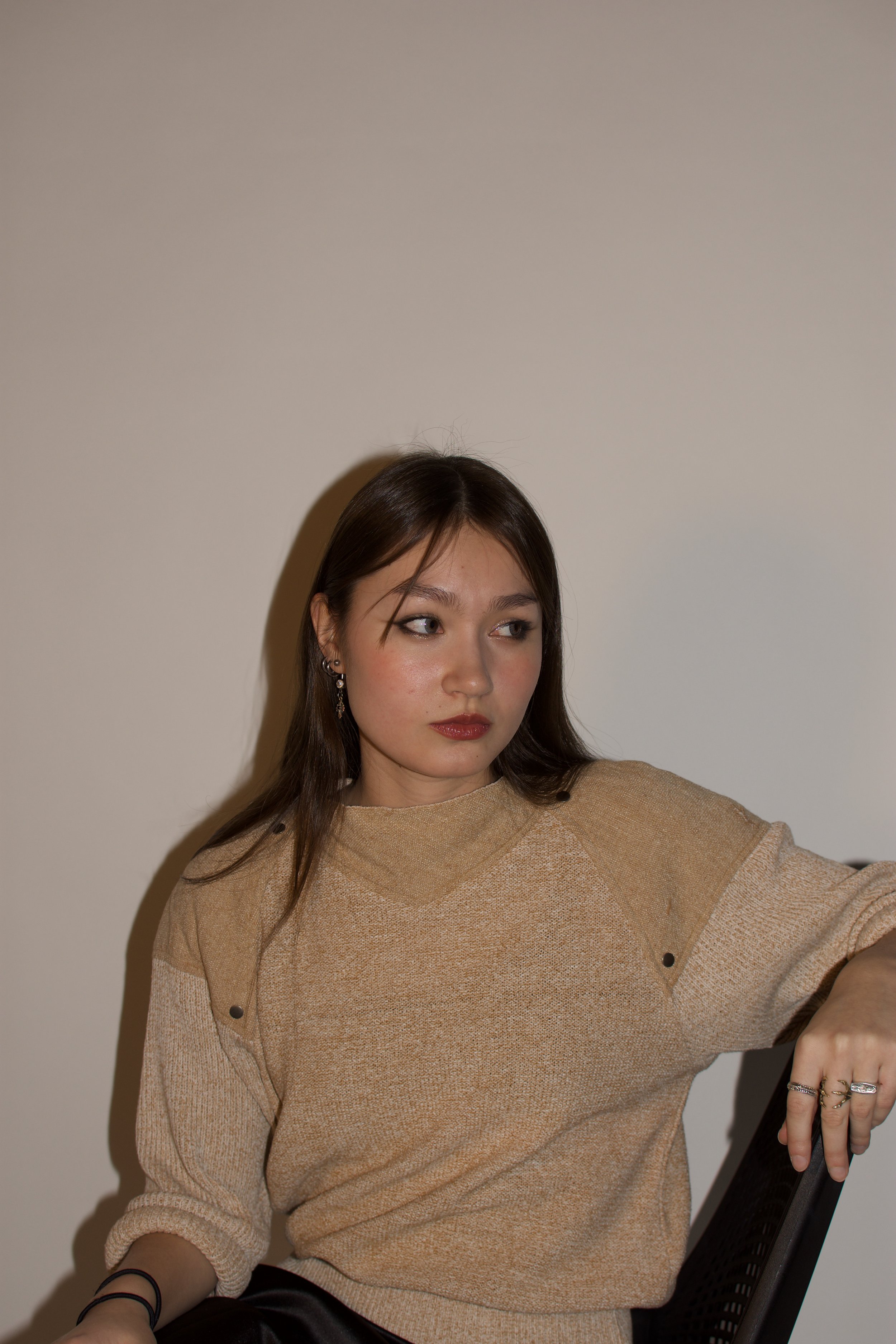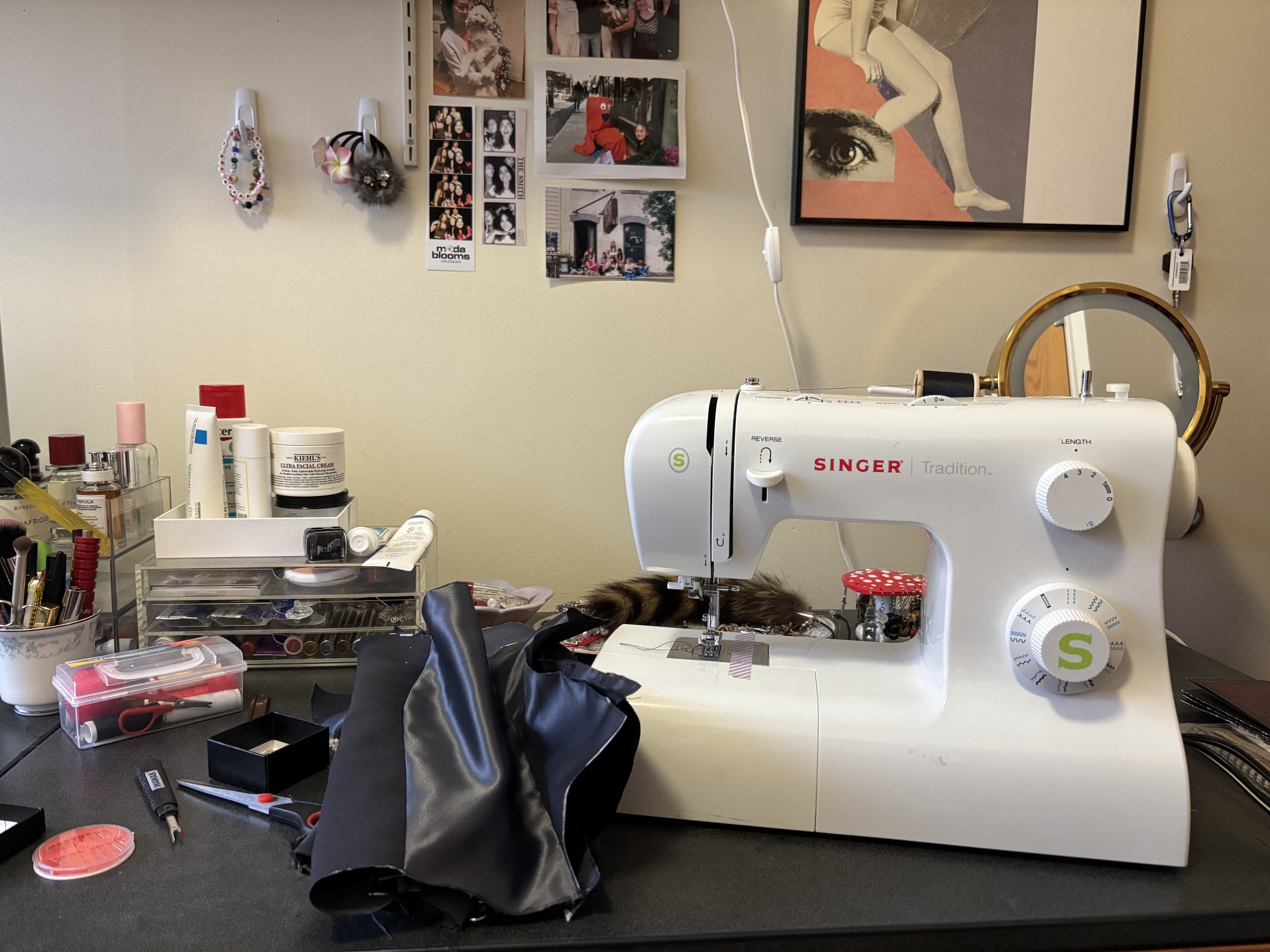2025 Designer Profile: Melia Moore
Melia Moore is a second year English major from Brooklyn, New York
What inspired you to start doing design and have you ever done fashion design work before?
When I was in my freshman year of high school, my friend was into sewing and she made costumes for this annual musical competition we had. So I joined that club and I learned how to sew there, and then I continued doing that for four years. One of the rules [of the competition] was every actor, dancer or singer on the stage had to be wearing one item that was handmade. So we had to make many tens of things. That taught me how to sew and gave me a lot of experience in sewing, though the focus there was definitely not the design aspects and more just getting a lot of things made. When I started designing things for myself, I got into historical fashion. The first thing I patterned by myself was a regency inspired dress, during the summer before my junior year of high school. In my junior year, I started doing these little projects–I made a little mini dress, a pair of shorts, which were pretty simple.
Melia’s sewing setup
Do you think living in New York at all influenced the type of fashion design you were doing and the type of things you were sewing?
Definitely. The garment district in New York is very extensive and you can buy anything you want in person, which just makes designing in New York way easier than here. People in New York are usually very well dressed. If you go to certain areas, there are so many very cool dressed people.
What inspires you, who do you have in mind when you're designing?
In terms of capital F fashion designers, I was thinking about the Schiaparelli Spring 2022 show. I really like the exaggerated structured silhouettes of a lot of those gowns. During my Senior year of high school, there was this Mugler exhibit at the Brooklyn Museum that I went to, and there were a lot of very cool armory type looks. I was inspired by this armory Paul Poiret dress. I was also inspired by late 1870s to early 1880s fashion, mainly because that is a part of the Victorian era where you don't need to have a humongous bustle underneath. I was focusing on the “natural form” period, which is around 1878 to 1883, where there was more practical skirts–I don't even know if they're more practical, because they are tighter around the legs and it still is an exorbitant amount of fabric, but it definitely looked more natural. During that period, the cuirass bodice was popular, which was inspired by actual armor. That was something I was trying to incorporate a lot. I made one corset that's supposed to look armory.
I was also interested in industrialization and metallic finishes and generally kind of rusty, dirty, sooty finishes. Also in the Victorian era, especially around the 1880s, feathers became a big thing, so I got feathers for one of my looks. I think it's cool to play with really hard, outer surfaces versus a softer inner. Which you can see on the Mugler dress (pictured above) that's on my moodboard. Another design inspiration is Lolita fashion. I was looking at a lot of Lolita dress, mostly Classic Lolita that looks like it has late 1870s, early 1880s influences.
Melia wearing a skirt from one of her looks for the upcoming MODA show
What's something you want to convey through your designs?
When I first designed the collection I wanted to have a story. I was reading To the Lighthouse by Virginia Woolf at the time, and I wanted my collection to somehow convey changing notions of femininity. To the Lighthouse is more ahead in time than the “natural form” era, but the era was somewhat modern with its more natural silhouette. At the same time, the cuirass bodice made it so women could wear jackets, which is more practical because they were mostly wearing capes before. I wanted to do one look that was very girlish and then some looks that looked more womanly; the womanly looks were [inspired by a period] further back in time than the girlish looks, so it depicted femininity across generations.
What are you most proud of about your designs?
I am proud of the fact that I thought through my designs a lot and I feel like I chose things very intentionally. With my costume past, I think I used to make a lot of design choices just based on what is easiest. I had been trained to make a design choice because it's easiest or had fewer seams. I think I've done a good job of moving away from that thinking and being very intentional with having solid references for elements in my designs. I'm also proud of myself for learning new techniques, because I've had to learn a lot of things by myself and it was challenging.
If your designs were a playlist, which artists would it feature?
I feel like the black and white color palette I'm going makes me want to pick something that's a little more somber or lacking flair. But I don't think that's the vibe of my collection at all. I think it's playful. I’m using techno for when the models are walking, but I don't think that the heart of the collection is techno. I want the historical bits to shine through and I want people to be able to recognize them, so I’ll say Debussy.
What are some of your future design goals?
Finding historical inspiration in different ways–I want to take a very specific time period and make that visually clear in the designs. I want to draw on different periods and see if I can echo those and mix them with more modern [trends]. It would be really cool to make a collection in which I try to convey ideas of fashion theory–deconstruction being a big thing–or like a collection of super exaggerated things.
Any other details you would want to include?
When you're viewing the show, understand that every garment takes a long time to make. It's really difficult to make clothes! There's things that you wouldn't think would take any time at all and then they actually takes two hours, like finishing garments on the inside. If things look messy, know that it does take a really long time, and [the designer] probably still put hours and hours into their clothes.













